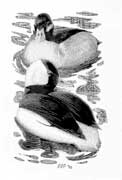|
 Earth Journal Earth Journal
by Gary Pendleton |
 Buffleheads, Cute as Rubber Duckies Buffleheads, Cute as Rubber Duckies
Buffleheads are appealing little ducks. So cute are they that even unsentimental, serious-minded birders — and I’ve known a few — have been known to coo when observing them. Who could blame them? There is something about a bufflehead that makes people get all mushy.
First there is the name, bufflehead. Christopher Leahy says in A Birdwatchers Companion that it originated as buffalo head. Early ornithologists thought the duck’s head shape resembled that of the European buffalo. All right … but I can’t help but believe they had a good laugh when they thought it up.
Also buffleheads are very small. They are one of the smallest of all duck species, about half the size of a mallard. Their diminutive stature is part of their emotional appeal.
Sitting in the water, male buffleheads show gleaming white plumage on their sides, contrasting boldly with dark wings. Their heads, their little buffle-heads, are dark with a white patch behind the eye.
Buffleheads are diving ducks. They disappear beneath the water quite suddenly, and when they emerge on the surface they seem to pop up like a rubber duck.
In the air, buffleheads — and all other ducks — shed any aspect of cuteness or goofiness. They are built for speed and fly like bullets with rapid wing beats. Peregrine falcons, birds known for the tremendous speed when diving through the air from above, might be able to reach up to 185mph in a dive. Flying flat out, they are unable to match the little bufflehead for speed.
Buffleheads are one of many species that winter on the Chesapeake Bay from roughly late October to late March. They breed in Canada and the northern tier of the U.S., building their nests in old woodpecker holes, or occasionally burrowed out holes in river banks.
This illustration of buffleheads is based on a wood engraving of tufted ducks by the late British artist Charles Tunnicliffe.
|
